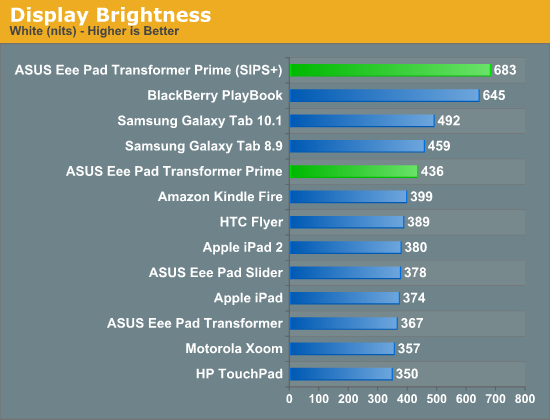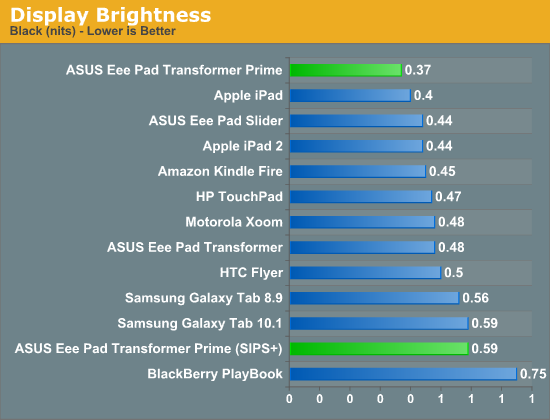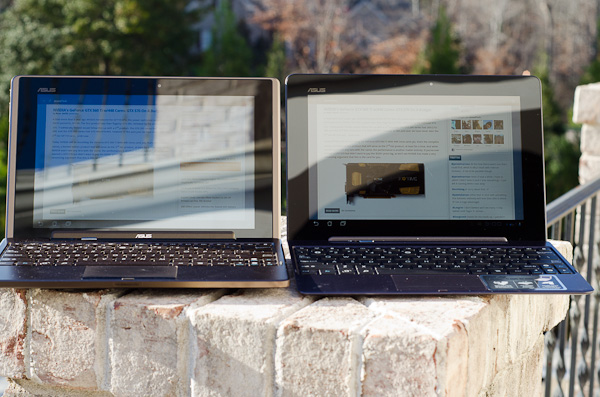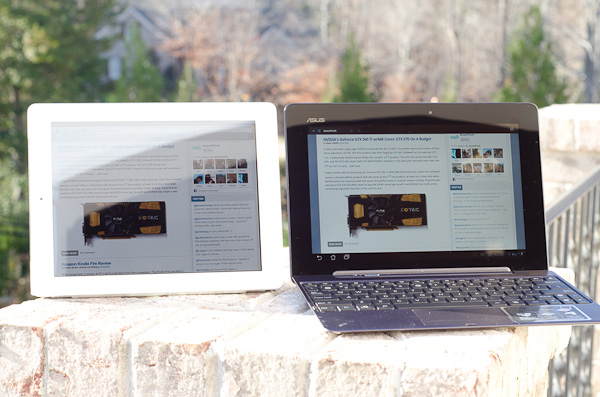ASUS Eee Pad Transformer Prime & NVIDIA Tegra 3 Review
by Anand Lal Shimpi on December 1, 2011 1:00 AM ESTThe Display: Perfect
The original Transformer had a display that performed similarly to the iPad, but was far more reflective thanks to a fairly large gap between the outer glass and the LCD panel underneath. I excused the first generation Eee Pad in the display department because it was good enough and $100 cheaper than the competing Apple solution. The Prime reaches price parity with the iPad 2, and as a result it must meet a higher standard. ASUS doesn't disappoint - the Eee Pad Transformer Prime has the best display I've seen on a tablet to date.
The resolution is a Honeycomb-standard 1280 x 800. The 16:10 panel measures 10.1-inches diagonally, giving it a very similar surface area to the iPad 2's 9.7-inch 4:3 display. The increase in resolution more than makes up for the larger screen however, ASUS delivers 145 pixels per inch compared to the iPad 2's now quite-dated ~132 PPI.
It's not all about pixel density here, the Transformer Prime has better white and black levels than anything else in its class. It also sets the new benchmark for contrast ratio at nearly 1200:1. The huge gap between the outermost glass and the IPS LCD panel has been reduced significantly, in turn reducing glare.



ASUS also has a Super IPS+ mode that drives the display to a class-leading 683 nits. The Super IPS+ mode obviously draws more power but ASUS recommends it if you're trying to use your tablet outdoors. In our review of the PlayBook we found that 600 nits was really the cutoff for usability in sunny conditions, and ASUS easily exceeds that. It's also worth pointing out that while Super IPS+ increases black levels as well, the resulting contrast ratio remains the same.

Original TF (left) vs. Super IPS+ enabled on the TF Prime (right)

iPad 2 (left) vs. Super IPS+ enabled on the TF Prime (right)
Viewing angles are absolutely awesome. Yes this is the same ASUS that let us down with the UX panels but it definitely got the panel right when it came to the Transformer Prime. Fingerprints are still going to be evident on the display but they don't seem to be as bad as on the original Transformer, and they do wipe off easily. This time around ASUS bundles a microfiber cloth to aid in keeping your Transformer looking fresh.
ASUS, Apple and the rest of the tablet world are in hot pursuit of even higher resolution panels, the problem is yields on these small 1080p and 2048x1536 panels just aren't high enough yet. The Android crowd will have to wait, although Apple is apparently pushing very hard (and trying to buy up a lot of inventory) to deliver a "retina display" equipped iPad 2+/3 by Q2 next year. I'm hearing Q3/Q4 for everyone else and it's still not a guarantee that Apple will be able to meet its aggressive targets either at this point.










204 Comments
View All Comments
joe_dude - Thursday, December 1, 2011 - link
Sorry Anand, but could you clarify what you mean by "getting actual work done"?I don't expect the Transformer Prime to be running Photoshop (although Photoshop Touch is available?) or any intense apps. But is it a "good enough" laptop for a general user?
Anand Lal Shimpi - Thursday, December 1, 2011 - link
Browsing the web is still faster on an MBA/ultrabook, pages load quicker, you can open multiple tabs and load them in the background more effectively - you can switch between tasks quicker (cmd+tab/alt+tab is still infinitely more responsive than what you get with Honeycomb's task switcher). You can get writing done on both, but multitasking and being productive is just easier on a MBA/ultrabook.Now both of those comparisons are ~2x the price of the Prime. Compared to a netbook, I'd definitely get the Prime.
Take care,
Anand
agt499 - Thursday, December 1, 2011 - link
Alt-tab was one of many things that impressed with my OG transformer -you don't use the honeycomb task switcher because you just alt-tab with the keyboard!I have to say asus really get it on that: I don't know for sure if it's asus or google , but the others that warm by keyboard-loving heart are ctrl-t for a new tab in browser and ctrl-w to close a tab.
Also re zooming, I can't speak for the prime, but the original will pinch-zoom with the touchpad.
Thanks for the great review -got to find an excuse to upgrade now!
(you're still right about an ultrabook but it feels like asus are so close...)
twotwotwo - Friday, December 2, 2011 - link
Ahaha -- I managed to use my Transformer all this time lamenting the lack of keyboard-based task switching but without actually trying Alt-Tab, which of course should be the first thing to try. Thank you, agt499.twotwotwo - Thursday, December 1, 2011 - link
I have an original Transformer that I've used as my work machine a few days, and I also used a netbook as my only machine for six months. Transformer's very much a tablet and not a computer, because of Honeycomb. The bad task switching and other annoyances -- different text-editing shortcuts, lack of a full Docs app, lag editing paragraphs in the browser, etc. -- mean it's fine for the reading/consumption that folks do on tablets (and better for e-mail, chat, some writing or notetaking, and SSH if you do that) but, for me, it's worse than even a netbook at other stuff.If you're thinking of it for tablet-y (or mostly tablet-y) uses it's a slam dunk: it's a tablet, great screen, mobile OS, monster battery life even vs. netbooks.
If you want a computer, you want a computer. Besides netbooks and ultrabooks, there's the Core i3 ULV x121e (and others like it soon, I hope) in the middle.
joshv - Thursday, December 1, 2011 - link
Why exactly don't we expect these sorts of machines to be running photoshop? Very complex versions of photoshop ran just fine on single core P6's with a 1024x768 monitor.Now we have four GHz+ cores, CPU speed really can't be much of an issue. Screen realestate might be, but that's manageable with alternate layouts.
metafor - Thursday, December 1, 2011 - link
I think the biggest limitation with programs like Photoshop on small form-factor devices -- including ultrabooks -- is the display resolution. Now granted, for a lot of simple photo editing, that won't matter -- and in fact, that's what Photoshop Touch is for -- but for more professional level content, the displays may just be too small and low-resolution to get the job done.But you're right, the processing power is there nowadays.
anactoraaron - Thursday, December 1, 2011 - link
I always assumed it was an x86 issue. Since there's no x86 support in these devices Adobe will not re-write/compile the software - kinda like how it took years to have a native x64 flash player (and not a x86 kinda running in an x64 browser).I would think it's simply a matter of laziness/unwillingness (profit margin?) on Adobe's part.
metafor - Thursday, December 1, 2011 - link
Photoshop Touch and a suite of other tools is coming to Android within a month or so. Adobe wants to grasp opportunities; but just porting a mouse-and-keyboard application to Android isn't the way to go about it.ctrlbrk - Thursday, December 1, 2011 - link
Anand, thank you. I have been eyeing this tablet for a long time now.I want to know your impressions of how it feels in your hands, weight wise? For bedroom surfing, email, youtube, etc -- but not movie watching -- is the 10.1 too big and too heavy? Is it better to get something like the Galaxy Tab 8.9?